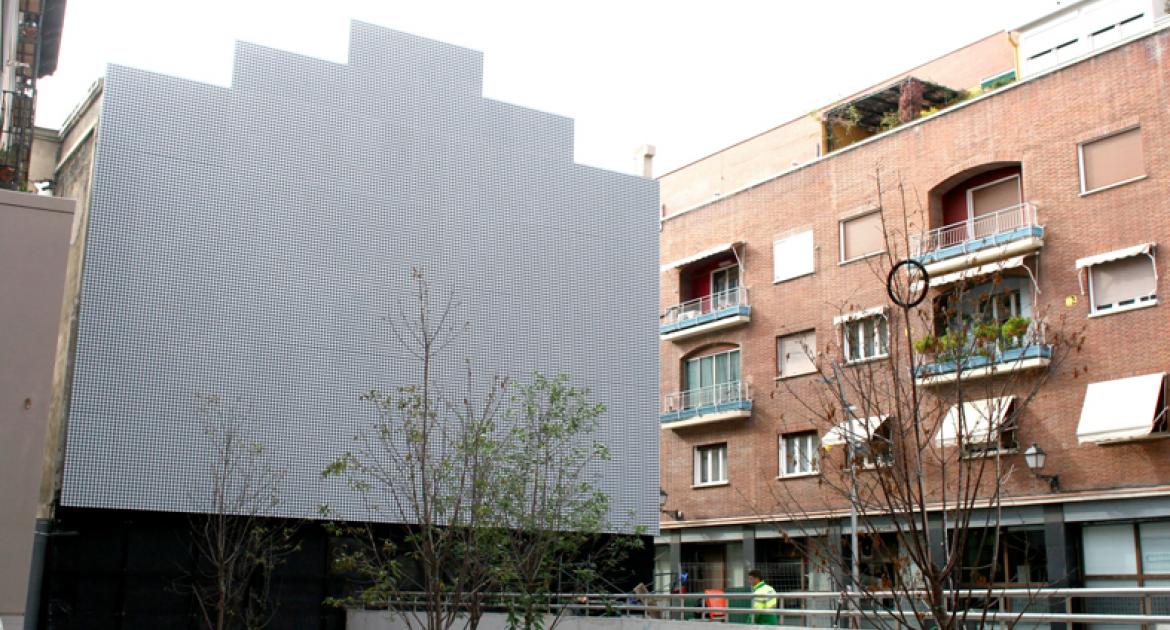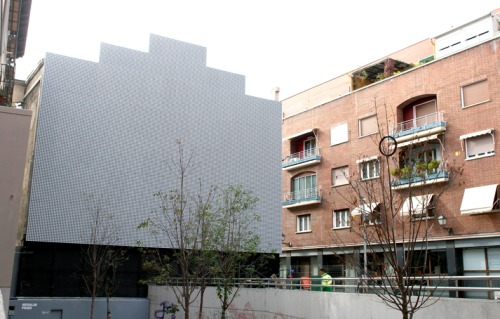Open Up Workshop: Call for projects

> Guidelines and project submission form
> General information about Media(nera)Lab plataform
> Technical Information on the Digital Façade of Medialab-Prado

Worskhop tutors: Jordi Claramonte, Chandler McWilliams, Casey Reas, and Víctor Viña. Coordinated by Nerea Calvillo.
Introduction
Until now, urban screens and digital façades have been greatly developed technically, but its contents, which are usually produced by advertisement agencies and occasionally artists, have been created, in many cases, during closed processes.
Open Up suggests opening the processes of content production and explores collaborative systems of interaction and creation related to the digital façade (and therefore, public space). This production can move among its different levels of intensity and development and can vary between two working environments: the platform for collective creation and its collective activation.
Aiming to create a platform of expression through the screen, the first is oriented towards involving collectives in the elaboration of contents by creating working groups or other participation strategies. The second is centred in producing tools for the collective reception and activation of the contents that appear in the screen. We need to consider that in both cases the participation can be stable, but also instant, invisible, multiple or disperse.
Depending on the cases, chosen projects should include the creation of strategies for participation, the development of the platform, the format for its visualization in the screen and the protocols for its activation. Also, the projects will need to define the context: the Plaza de las Letras, the neighbourhood’s local environment or the city of Madrid. The physical and/or virtual participation will be identified considering all these factors.
Projects presented in this call will have to explore one of the following aspects:- Proposals referring to the development of strategies for public participation, during any of the project’s phases.
- Proposals that encourage ways to activate urban space through the screen.
- Proposals that favour a stronger public visibility of agents that normally have none.
- Prosals that visualize public collectives.
- Proposals that develop new ways to activate and interact with the screen among users and portable devices such as cell phones, videogames, lasers, etc.
- Proposals that include emerging systems and processes that allows this project to evolve and change through time.
Tutor's approach
"Conventional public art tended to be defined as an aesthetic object related to the specific physical location where is destined to be. In contrast, the emerging public art practices from the 90´s constituted of interventions in the public domain that included the process of discussion, the creation of a will and the construction of a project for a community, which will house subsequent work that makes sense, this is what we want to talk about.
To talk about collaborative work should not lead us to think that what was before negotiated with an “authority”-like the installationof a doll on a horse- should now be necessarily agreed with a “community”, more or less misty, more or less unreachable.
The community with which we are going to collaborate might be there or might not be there. Even we might have to build it. Maybe we, the artists, are part of this community and did not realized.
Working in a public space-as MediaLab Prado´s screen does- implies to assume a new dimension in our work: the political and social articulation of a community, or half a dozen of them, of communities that exist or that are newly created.
So, we could portray ourselves and assume that what we call “collaborative art” is the process in which a group of people build the specific conditions for an environment with a particular freedom. This is possible by producing a homogeneous environment with a certain approach to relations, which in the case of a public intervention, as we mentioned, it will probably have consequences in the articulation of a community, previously existent or capable of being created around our intervention." By Jordi Claramonte
"Developing a framework for an open digital façade allows us to interrogate the life of the city from a multiplicity of scales. At the cellular level, the people in the city, moving through the city; city as system and background for our daily lives. We also have the city as an individual, as a whole in and of itself, living and growing as an organism. Both of these scales present interesting questions. How will an open digital façade alter the flow of people in the city? What new ways of acting will emerge from the affordances it provides? How can a protocol be developed to facilitate the creation of thriving micro-publics? As the mobile phone has changed the life of the individual, how can this open façade change the city? Here we are presented an opportunity to test these questions experimentally, through rapid iterative prototyping; and in so doing, we can generate new problems that further redefine the meaning of city, space, public, and façade." By Chandler McWilliams
"I'm fascinated with the public screen as a platform for diverse types of expression. Like public-access television and public radio, I imagine it to be programmed in diverse ways for many audiences. The content may change from hour to hour, night to night, season to season. For example, participatory games that turn the Plaza into an area, tools that allow children to make animated stories and present them, ambient environments that create a mood, augmented performances that envelop the Plaza, etc. I think the beauty of this opportunity to experiment and explore many ideas openly and publicly and to see what resonates. To make quick prototypes and discover what works, rather than guessing. As an outsider to Madrid, and the neighborhood, I don't have insight into what is needed, but I have many ideas to explore. " By Casey Reas
"The integration of open systems of visualization in public space offers opportunities to explore new possibilities including the interaction of the people living in the city with digital media. The combination of these systems with computer physical tools, mobile devices and the creation of technological artifacts capable of communicating can generate platforms for the transmission of information, for games, for collaboration, for the creation of social capital and for the expression of individual and collective interests.
Therefore, it is necessary to consider new strategies of intervention that can be applied in the context of the city considering the specific nature of each public space, taking the semantics of singular objects present in each location as a reference and proposing new models of integration that can generate hybrid spaces that stand between the physical and the virtual, between the analogical and the digital and between real and fictitious.
The core of the workshop will be focused in the conceptualization and visualization of possible systems that can integrate Madrid’s public space with the installation Led Action Screen. Support will be offered for the development of platforms with sensors, actuators, controllers, radio frequency communication, security systems, wearables, obsolete devices, urban furniture and other elements that allow the creation of proposals that bring to the contents of the installation a tangible side focusing in the people’s presence.
The elements used will be mainly open hardware tools though an interactive working process that allows the production of functional prototypes in the workshop." By Víctor Viña



 Medialab-Matadero Madrid
Medialab-Matadero Madrid